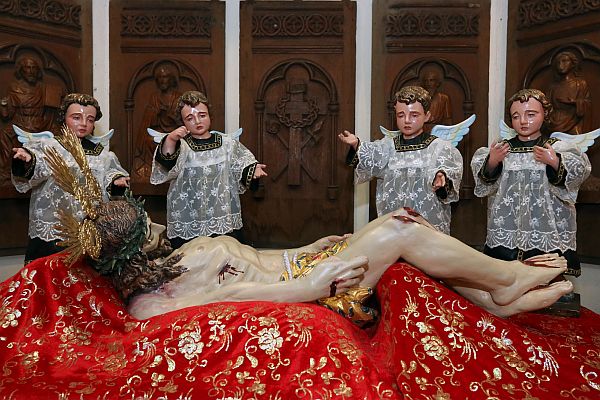
An image of Jesus Christ presented by a Roman soldier to Pontius Pilate is on display at the Archdiocesan Museum of Cebu as part of the Lenten exhibit by renowned Cebuano iconographer Louie Nacorda.
CDN PHOTO/JUNJIE MENDOZA
Images of Christ’s passion and death
(Conclusion)
Aside from the tableaux of Jesus’ passion and death, key personalities who accompanied Jesus in His final hours are also presented in the pasos, or the religious images that portray Jesus’ final hours on earth.
Among them are Jesus’ sorrowful mother, popularly known as the “Mater Dolorosa” (Sorrowful Mother), St. John the Evangelist, St. Peter, St. Mary Magdalene, St. Mary Jacobe, St. Salome, and St. Veronica.
St. John was the only apostle who stayed with Jesus until the Lord breathed His last in Calvary, said heritage enthusiast and renowned Cebuano iconographer Clodoveo “Louie” Nacorda.
St. Mary Magdalene, on the other hand, was the woman Jesus freed from seven demons and was among the few who were on the foot of the cross; and who on Easter Sunday morning Jesus sent to tell the apostles that He has risen from the dead.
Contrary to earlier claims, Nacorda said there has been no sufficient proof that St. Mary Magdalene, her image bringing a bottle of perfume, was the same woman portrayed as a prostitute in the Scriptures.
St. Mary Jacobe, depicted as carrying the flagrum or Roman whip, or in some images a broom, was the mother of St. James the lesser, one of the apostles of Jesus; while St. Salome, another follower of Jesus, brings an incense.
By tradition, the woman who wiped the bloodied face of Jesus using her veil was St. Veronica. St. Martha of Bethany, who prepared meals for Jesus and his disciples, joins the women in the passion of Christ.
The other personalities in the passion of Christ were Joseph of Arimathea, a follower of Jesus, who along with Nicodemus, a Pharisee who came to see Jesus one of those nights, cleaned and buried the body of the Lord; and St. Longino, the Roman soldier who pierced the side of Jesus and was eventually converted.
St. Peter’s role
And why is St. Peter included in the pasos when he denied Jesus thrice and left the Lord in the passion narrative?
Nacorda said the image of St. Peter which usually leads the pasos procession and the sacred walk on Good Friday is a reminder of what the celebration is all about.
“The St. Peter you see in the pasos is the image of the apostle who denied Christ three times, never lost hope, and repented. He represents the true essence of Lent because he mirrors all of us, sinners, who should find our way back to God,” he said.
As repeatedly explained by the Catholic Church, Nacorda said religious images simply represent the holy persons of God and are not being worshipped by Catholics.
“They serve as visual aids to help us visualize what we cannot see. We don’t worship pieces of woods or cement or any other material. Why should we? All these religious images are but representations that we simply venerate in the same manner that we look up to statues of our heroes,” he explained.

Four sorrowful angels look at an image of the dead Jesus Christ lying in repose at the Archdiocesan Museum of Cebu.
CDN PHOTOS/JUNJIE MENDOZA
Veneration and devotion
While God prohibited His people from making graven icons of idols, Nacorda said images of Jesus, the saints, and angels represent the divine and should not be considered as idols or deities.
In the Scriptures, Nacorda said God Himself instructed Moses to “make two cherubim (angels) and put them on the Ark of the Covenant.”
When the Israelites were bitten by snakes in the wilderness, he said God also commanded Moses to make a bronze serpent, and anyone who looked at it was healed.
“Catholics don’t worship images. We venerate. The honor paid to sacred images is a respectful veneration and not the adoration due to God alone,”
said Nacorda, who owned the sacred images and a tableau depicting Jesus’ suffering and death on display at the Archdiocesan Museum of Cebu.
The Lenten exhibit is open daily to the public, free of charge, from 9 a.m. to 12 noon; 1 p.m. to 4:30 p.m. until April 30.
“The pasos is a form of devotion. Even how beautiful or expensive your images or their vestments are, unless you practice that devotion, everything is useless. Art in religion is meant to move us to piety and bring us closer to God. In this season of Lent, they help us ponder upon the mysteries of our salvation and hopefully bring us to repentance,” Nacorda said.
Disclaimer: The comments uploaded on this site do not necessarily represent or reflect the views of management and owner of Cebudailynews. We reserve the right to exclude comments that we deem to be inconsistent with our editorial standards.
